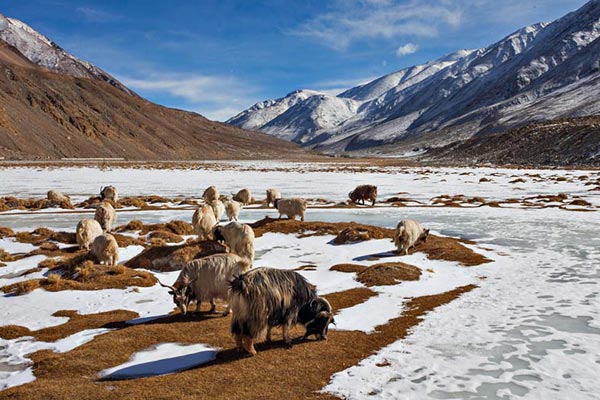
Wildlife In Leh Ladakh
Ladakh has a very rich flora and fauna. Several species of them are endemic to the region. Due to its unique climate and topography, distinct species of animals are found in Ladakh. The snow leopard and the black-necked crane are the jewels of the wildlife kingdom of Ladakh along with several other unique birds and mammals.
In the pastures of eastern Ladakh, wild animals and birds are a common sighting and often compete with domestic animals for food. While in the heavily populated Indus valley and the valleys of its tributaries, they are found in the higher reaches but often descend to lower reaches due to scarcity of food, thus resulting in human-wildlife conflict. Several species of mammals which were extensively hunted for fur and wool in the past are now at the brink of extinction. These include the Tibetan antelope, Eurasian lynx and the musk deer which is now extinct in Ladakh.
Due to the revival of Buddhist traditions and the increasing awareness of the populace regarding the importance of preservation of environment, the future looks seemingly bright for the wildlife of Ladakh.
Mammals of Ladakh
1. Snow Leopard
The snow leopard is one of the rarest mammals in the world. Called Schan in Ladakhi language, it is the king of snow-capped mountains. It is smaller and lighter than a common leopard. The snow leopard is a nocturnal animal and is very elusive. It is adapted to live in some of the most climatically hostile environments, in high-altitude mountains and extreme cold. The head, nape and lower parts of legs have black spots while the body and tail is covered with larger rosettes and the belly is witish. The snow leopard inhabits areas especially between 3,000m and 5,000m. It is found throughout Ladakh especially in southern and central Ladakh. Hemis National Park is the best place to view this ‘Grey Ghost’.
2. Tibetan Wolf
Called Shangku in Ladakh, the Tibetan wolf is a sub-species of grey wolf. It is around 76 cm tall and about 110 cm in length. It weighs around 30-35 kg. It is larger than the other sub-species of wolf found in the Indian Peninsula. It has a blackish summer coat and a brownish thick woolly fur in winter. Its fur is black on the back while yellowish white on face, belly and limbs. The Tibetan wolf is found mostly in the mountains during summer and in the upper reaches of valleys during winter. It mostly preys on rodents but often hunts livestock leading to retaliatory killing by the locals. It lives mostly in Changthang region, Zanskar, Upper Suru valley and Markha valley.
3. Eurasian Lynx
Like the snow leopard, the Eurasian lynx is one of the rare mammals on the planet. It is almost extinct in Europe, since it has been extensively hunted for its fur which is in great demand in the fashion industry. Its body is reddish grey with spots over the upper limbs. Its distinctive feature is long tufts of hair on its erect, triangular shaped ears. The Eurasian lynx inhabits in areas at an altitude of over 4,000m. It is a diurnal mammal, especially active at dusk and dawn. It hunts marmots, hares, young ones of bharal and domestic sheep and goats. It is mostly found in the Nubra valley near Hunder and Panamik and in Gya-Meru area.
4. Red Fox
Known as Watsey in Ladakhi, the red fox is common throughout Ladakh. Its coat is reddish in colour. It is covered with long, silky fur for which it is extensively hunted. As a result, its population is declining. The red fox is active at night but can also be seen at dawn and dusk. It is a very shy and wary animal. It is mostly found individually as well as in monogamous pairs. The red fox lives in crevices and burrows. It feeds on marmots, mouse-hares, rodents and birds.
5. Himalayan Brown Bear
The Himalayan brown bear is a sub-species of brown bear. It has a reddish brown coat. It is regarded as one of the largest carnivore in the Himalayas. It has a large head with small eyes, a heavy body with stocky limbs and flat claws. The Himalayan brown bear lives individually or in small groups with female and cubs. It prefers bare, open areas. It is active both during daytime and at night but rests during midday. It goes into hibernation from November to May. The Himalayan brown bear is territorial with the male territory larger than the female’s. It is omnivore and feeds on fresh grass, insects, rodents, roots, bulbs, carcasses and even livestock. It is found in western and southern Ladakh.

